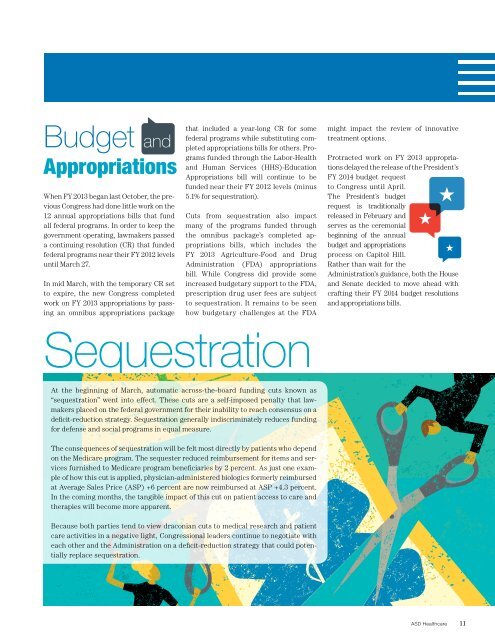media - ASD Healthcare
media - ASD Healthcare
media - ASD Healthcare
Create successful ePaper yourself
Turn your PDF publications into a flip-book with our unique Google optimized e-Paper software.
Budget andAppropriationsWhen FY 2013 began last October, the previousCongress had done little work on the12 annual appropriations bills that fundall federal programs. In order to keep thegovernment operating, lawmakers passeda continuing resolution (CR) that fundedfederal programs near their FY 2012 levelsuntil March 27.In mid March, with the temporary CR setto expire, the new Congress completedwork on FY 2013 appropriations by passingan omnibus appropriations packagethat included a year-long CR for somefederal programs while substituting completedappropriations bills for others. Programsfunded through the Labor-Healthand Human Services (HHS)-EducationAppropriations bill will continue to befunded near their FY 2012 levels (minus5.1% for sequestration).Cuts from sequestration also impactmany of the programs funded throughthe omnibus package’s completed appropriationsbills, which includes theFY 2013 Agriculture-Food and DrugAdministration (FDA) appropriationsbill. While Congress did provide someincreased budgetary support to the FDA,prescription drug user fees are subjectto sequestration. It remains to be seenhow budgetary challenges at the FDAmight impact the review of innovativetreatment options.Protracted work on FY 2013 appropriationsdelayed the release of the President’sFY 2014 budget requestto Congress until April.The President’s budget ★request is traditionallyreleased in February andserves as the ceremonial★beginning of the annualbudget and appropriations★process on Capitol Hill.Rather than wait for theAdministration’s guidance, both the Houseand Senate decided to move ahead withcrafting their FY 2014 budget resolutionsand appropriations bills.SequestrationAt the beginning of March, automatic across-the-board funding cuts known as“sequestration” went into effect. These cuts are a self-imposed penalty that lawmakersplaced on the federal government for their inability to reach consensus on adeficit-reduction strategy. Sequestration generally indiscriminately reduces fundingfor defense and social programs in equal measure.The consequences of sequestration will be felt most directly by patients who dependon the Medicare program. The sequester reduced reimbursement for items and servicesfurnished to Medicare program beneficiaries by 2 percent. As just one exampleof how this cut is applied, physician-administered biologics formerly reimbursedat Average Sales Price (ASP) +6 percent are now reimbursed at ASP +4.3 percent.In the coming months, the tangible impact of this cut on patient access to care andtherapies will become more apparent.Because both parties tend to view draconian cuts to medical research and patientcare activities in a negative light, Congressional leaders continue to negotiate witheach other and the Administration on a deficit-reduction strategy that could potentiallyreplace sequestration.<strong>ASD</strong> <strong>Healthcare</strong> 11






